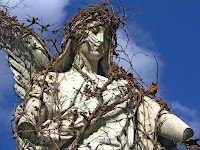As an explanation for the title of this blog (which I happen to be writing in July), we in the northeast part of the United States equate Christmas with snow (and sometimes snow with Christmas). The wintry image you see here was the subject of an interesting bit of yin and yang for me this past weekend, not just because it looks like Christmas in July.
I had a table set up with my artwork at the annual AGS (Association for Gravestone Studies) conference (at Monmouth University, West Long Branch, New Jersey), where I was selling books, prints, and cards of my photographic images. The particular image above was among two dozen assorted cemetery statuary prints mounted in 16 x 20 inch mats (which I sell for about $40). Several people asked about this one – where it was taken (Holy Cross Cemetery, Yeadon, PA), is the snow real or Photoshopped (real), etc. However, two potential customers had diametrically opposite views of the same image, within minutes of each other. Points of comparison among alternatives always exist, but are usually not so evident or obvious. One woman looked at it and visibly shuddered, saying “I don’t ever want to be reminded of snow. I lived in Ontario for five years and got tired of it really fast.” Soon afterward, another woman came by, fell in love with the image, and bought it. She said, “I’ve never seen snow.”
 |
| "Bird Girl" cover |
- Bonaventure’s management is not too keen on visitors; and
- the statue is gone!
Wikipedia tells us that the title Midnight in the Garden of Good and Evil “alludes to the hoodoo notion of ‘midnight’, the period between the time for good magic and the time for evil magic, and ‘the garden of good and evil,’ which refers principally to Bonaventure Cemetery". Yet another example of yin and yang - good and evil - complementary opposites, as it were.
Most of the cemetery photography that I exhibit and sell is still life. Not all pretty angels, but generally not disturbing images. Many people like that. The snow scene is dynamic, on the other hand. The experience of the two women's opposing points of view got me to thinking about actually using the balance of forces known as complementary opposites. As further evidence, I also had with me for the first time, a portfolio of “Abandoned Cemetery" images. People gravitated to this like butter to a biscuit. Again, opposites. Yin and yang. Good versus evil. Even these seasoned conference attendees, who know a thing or two about abandoned cemeteries, were quite interested in fine art depictions of these sad states of affairs. In the future, I will more consciously include a mix of both static and dynamic, good and evil imagery in my exhibits.
 |
| Abandoned grave, Mt. Moriah Cemetery (Phila.) |
References and Further Reading:
Savannah Attractions
Midnight in the Garden of Good and Evil, by John Berendt (The book, by the way, has little to do with the cemetery. I was somewhat disappointed when I read it. Apart from a sex scene in the cemetery, Bonaventure’s major role is to simply afford an enticingly creepy cover for the book.)
Midnight in the Garden of Good and Evil, by John Berendt (The book, by the way, has little to do with the cemetery. I was somewhat disappointed when I read it. Apart from a sex scene in the cemetery, Bonaventure’s major role is to simply afford an enticingly creepy cover for the book.)















